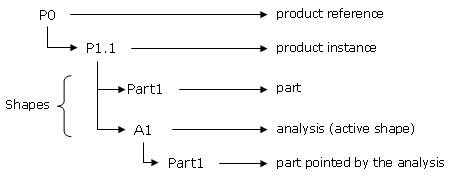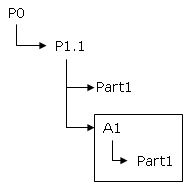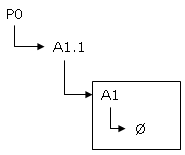You will find here general information about the Analysis Assembly concept.
This functionality is only available in the Generative Assembly Structural Analysis (GAS) product.
Analysis assembly provides a general solution based on reusability of the analysis document (.CATAnalysis file). Consequently the simulation of a complex product structure can be split into several independent sub-analysis performed by several users and assembled together in a global analysis called assembled analysis.
The Analysis Assembly definition will be done in both the Generative Structural Analysis workbench and the Advanced Meshing Tools workbench.
All analysis data (such as mesh, properties and materials) are retrieved without data duplication.
You can find here the notations used in this document:

The supported product structure are:
|
Product Structure: |
Assembly of: |
|
|
Analysis on Part
|
|
|
Orphan mesh (imported mesh) A1 is not pointing any geometry. |
-
Finite Element Model:
Properties and mesh parts can be defined either in the sub-analysis or in the assembled analysis but the mesh part and its associated property must be defined in the same analysis (under the same Analysis Manager). -
Analysis Connections:
You can connect sub-analyses using general analysis connection, point analysis connection, line analysis connection, surface analysis connection. -
Connection Properties:
-
All the welding connection properties (spot welding, seam welding and surface welding) are authorized in the assembled analysis. All these connections can be applied between mesh parts and geometrical bodies.
-
All Face Face and Distant Connection Properties are authorized in the assembled analysis if you apply them to a general analysis connection built with geometry as support.
To know more about the properties you can apply to a general analysis connection, refer to About Connection Properties. -
Some Face Face and Distant Connection Properties are authorized in the assembled analysis if you apply them to a general analysis connection built with groups as support.
You will see in the following table which connection property you can apply to a general analysis connection with groups as support:Geometrical Groups
Groups by Neighborhood
Spatial Group
Group by Neighborhood
Connection Properties
Point Group
Line Group
Surface Group
Point Group
Line Group
Surface Group
Box Group
Sphere Group
Line Group
Surface Group
Contact

3D support only
3D support onlySlider


Fastened





Fastened Spring





Pressure Fitting

3D support only

3D support onlyBolt Tightening



Rigid










Smooth










User-Defined
(with Contact as Start and End option)

User-Defined
(with Bolt as Middle option)





User-Defined










-
-
Pre-processing Specifications:
The pre-processing specifications such as restraints and loads can be defined either in sub-analysis or in the assembled analysis.
The pre-processing specifications defined in a sub-analysis will be ignored in the assembled Finite Element Model.
All the functionalities belonging to the Generative Part Structural Analysis (GPS) product and the ELFINI Structural Analysis (EST) product are available in the assembled analysis. These specifications can be applied on any geometry and groups of the specification tree. They are automatically linked to all meshes throughout the assembly. -
Solving Process:
The standard simulation solving processes are supported in the analysis assembly context. -
Post-processing Specifications:
The result management is supported in the analysis assembly context. Finite element visualization is available on assembly, as well as sensors and reporting.

